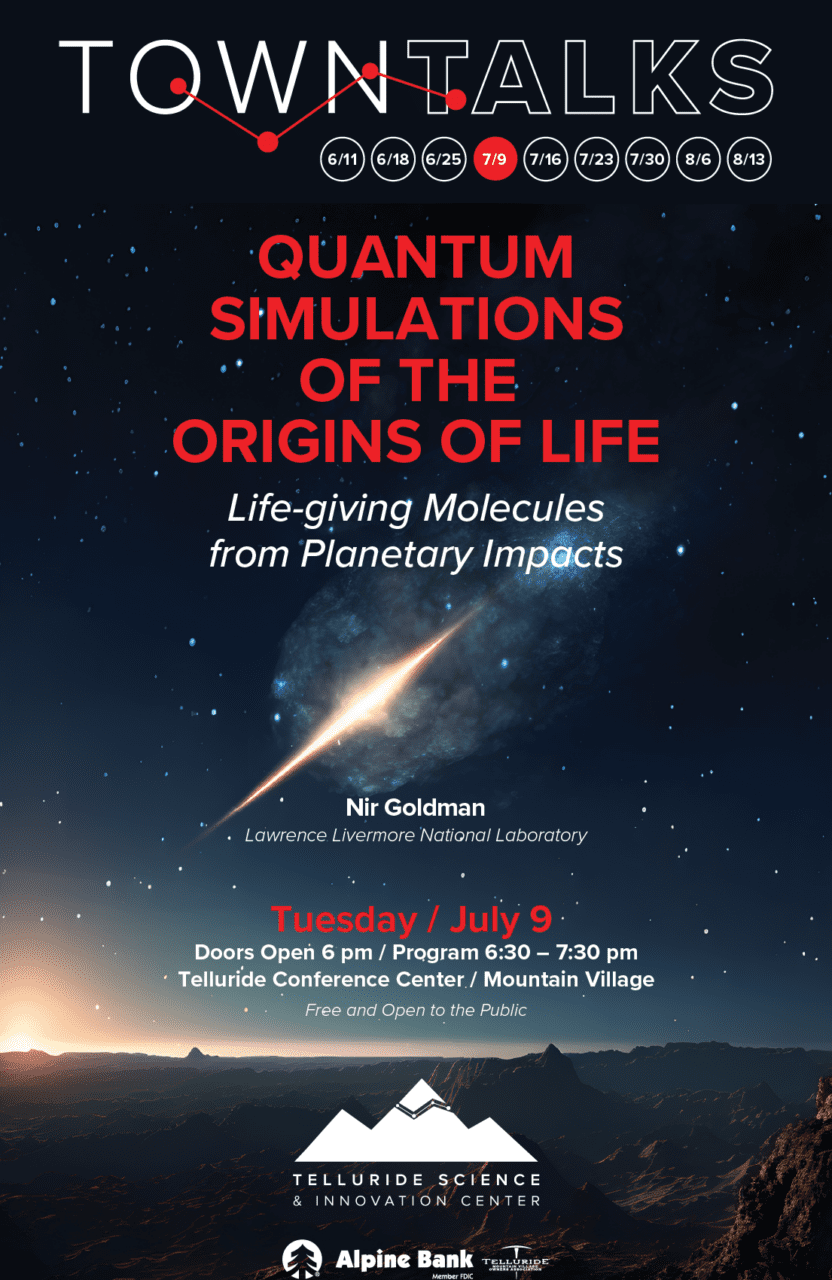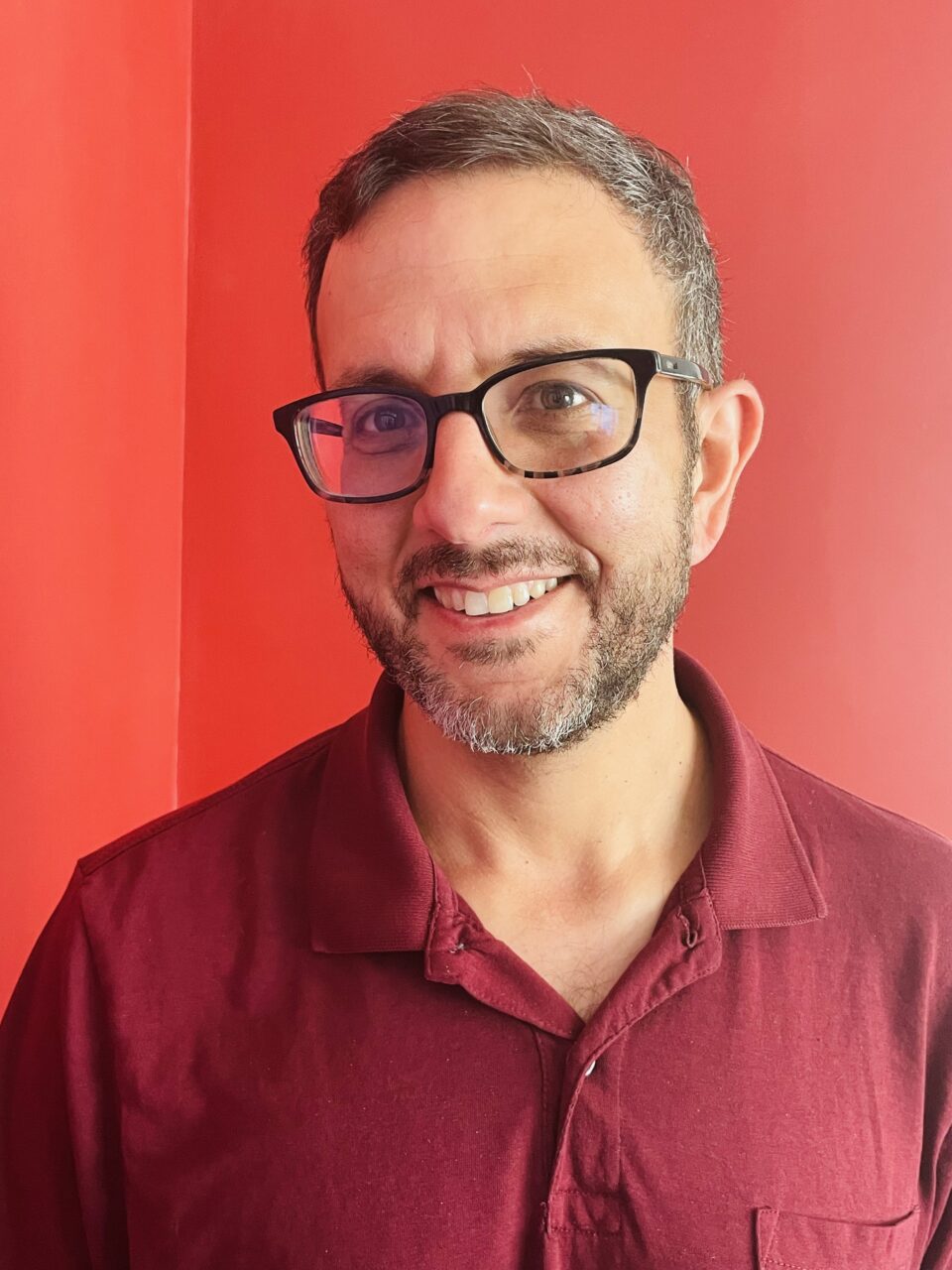
03 Jul Telluride Science Town Talks: “Quantum Simulations of the Origins of Life,” 7/9!
This coming week the 2024 Telluride Science Town Talks series continues with Dr. Nir Goldman. His subject is titled “Quantum Simulations of the Origins of Life: Life-giving Molecules from Planetary Impacts.” The event takes place Tuesday, July 9, 6:30 pm; doors, 6 p.m., at the Telluride Conference Center in Mountain Village.
Town Talks are FREE and open to the public.
Note: Telluride Science is committed to expanding its public outreach programming. This summer, the non-profit is hosting the greatest number of Town Talks held to date, a total of nine. All Town Talks take place the Telluride Conference Center.
Visit telluridescience.org to learn more about Telluride Science and the capital campaign to transform the historic Telluride Depot into the Telluride Science & Innovation Center. The venue is soon to be a permanent home for Telluride Science and a global hub of inspired knowledge exchange and development where great minds get to solve great challenges.
The 2024 Telluride Science Town Talks series is being presented by Alpine Bank with additional support from the Telluride Mountain Village Owner’s Association.
Go here for more about Telluride Science.
Go here for more on Town Talks.

Imagine Planet Earth four billion years ago. It was a dark, desolate world, devoid of life. Constant volcanic eruptions scarred the face of the land, leaving it black and rugged. Upheaving lava flows spread far and wide. Asteroids rained down like hail, mercilessly shaping and reshaping the rocky landscape.
Clearly the world of today is vastly different. It is a place full of life, diverse and vibrant. Lush forests, teeming oceans, and living creatures fill every corner of the Blue Marble we call home.
Those dramatic changes beg the questions: How did such a dramatic shift occur? How did Earth transform from a rocky wasteland into the flourishing world we know today and how did life first begin?
Certainly life did not just spring out of the rocks.
Statements and questions like those open the door to the subject of abiogenesis.
“Abio what? you say.
Abiogenesis is “the chemical process by which simplest life emerged from inanimate beginnings” (National Institutes of Health).
A subject central to Dr. Nir Goldman’s ongoing work.
Dr. Nir Goldman’s research suggests that life might have, after all, sprung from rocks. But not just any rocks. We’re talking comets.
On July 9, Dr. Nir Goldman is the Telluride region to present a Town Talk titled “Quantum Simulations of the Origins of Life: Life-giving Molecules from Planetary Impacts.” The event takes place at the Telluride Conference Center.
“Early Earth was an inhospitable place which was often bombarded by comets and other large astrophysical bodies. Those icy masses likely contained many small molecules that could have served as raw materials. Striking a glancing blow to a planet could have produced just the right amount of energy to drive the synthesis of those potentially life-building compounds.”
No doubt a fascinating insight. Goldman further notes that a comet’s impact creates intense temperatures and pressures, so intense the elements carried by the comet are given just the right oomph to form bonds and create the basic molecules for life.
“In our work, we have used quantum simulations to explore that hypothesis and help catalog how different astrophysical icy mixtures and impact conditions on a planetary surface could have resulted in amino acids, peptide-like structures, and large aromatic compounds. The goal (of my work) is to help create a chemical roadmap from the bottom-up that can help answer open questions regarding prebiotic chemistry.”
(For the record, amino acids are the building blocks of proteins and enzymes that play crucial roles in the development of all living things.)
Goldman believes his research at the Lawrence Livermore National Laboratory not only will help in our understanding of the origins of life in the past, but also feed into advancements for the future. By recreating the intense pressures and temperatures found in comet collisions, novel molecules can be created and selected for desirable properties such as enhanced conductivity or durability with ramifications for practical, industrial applications.
Further, through his work, Goldman hopes to come to an understanding not only about the origins of life on Earth, but also about the implications for the creation of life on other planets throughout our galaxy. Because astrophysical impacts are not limited to our celestial home.
Perhaps alien life is more likely than we ever thought.
Nir Goldman, more:

Nior Goldman, courtesy, Telluride Science.
Nir Goldman attended Yale University where he received a Bachelors of Science in Chemistry. He continued his studies at the University of California Berkeley earning a Ph.D in Physical Chemistry.
In 2018, Goldman was named a Fellow of the American Physical Society. Today he is a Deputy Group Leader for research at the Lawrence Livermore National Laboratory, focusing his work on the formation of molecules under extreme conditions.


Sorry, the comment form is closed at this time.